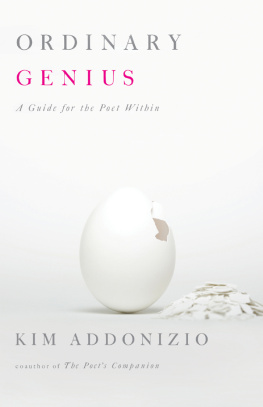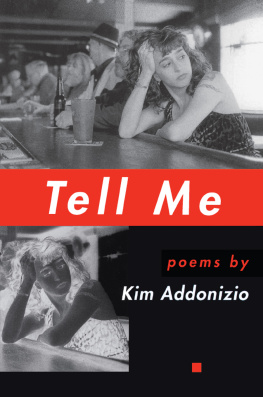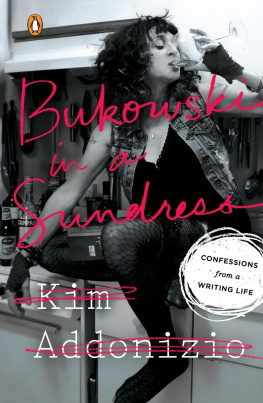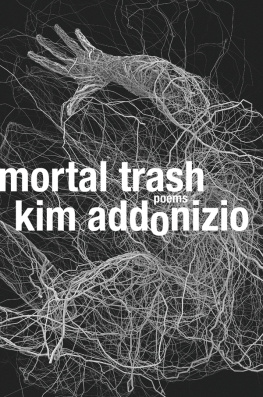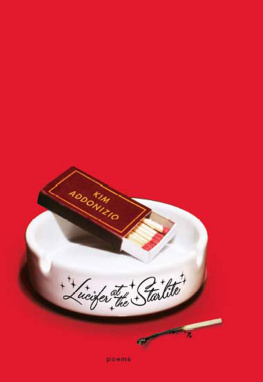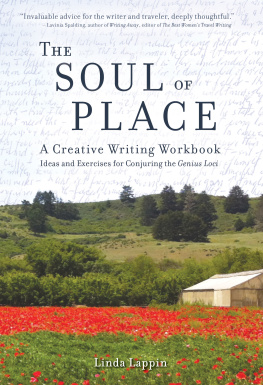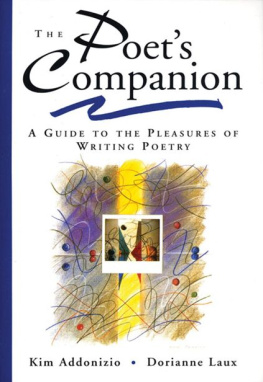

for my students
contents
T his is a book about creativity. Poetry happens to be its main subject, because poetry is my main vehicle: my way of traveling through life, of taking in the world and trying to give something back. It is a book meant to inspire you, whoever you are, no matter your level of skill or ability, your age, or what circumstances brought you to these pages. It contains ideas about life and art, self-destruction and self-expression, difficulty and pain and failure, joy and ease and perfect moments. These ideas are meant to encourage you, challenge you, and lead you more deeply into your own life and poetic practice. It doesnt matter if you want to write only for yourself, or for publication. Whether you believe that you are wildly talented, or are haunted by the thought that you just arent, and never will be, good enough.
Inspire : to breathe in.
Breathe in this book. Youll find ideas for making poemsa lot of them. Not every idea here is going to work for everyone, but there are some that will turn you sideways, jolt you into something completely unexpected, and keep you up nights. Some of the exercises are also aimed at leading you toward experiencing poetry in all its forms, rather than toward poems as end products. Poems arent products, anyway. Poems are what you make when you experience life in a certain way. Alive to yourself in the world, observant of inner and outer reality, and connected to language.
A few years ago, I wrote a book called The Poets Companion with another poet, Dorianne Laux. We wanted it to be a guide for people beginning to write poetry, an introduction to the pleasures of putting words together in surprising and beautiful ways. The Poets Companion has been widely used in creative writing classrooms, and by many individuals starting out. It has also been helpful to poets already writing and publishing, because the exercises in it are just as fruitful for those with more skill and experience. Accomplished writers are always interested in new approaches to craft and new challenges to their imaginations. We all sometimes need a jump start, or a fresh perspective.
This book, like The Poets Companion , contains discussions of the techniques of poetry as well as the process of creating it. Since publishing The Poets Companion, Ive continued to think about what good poetry is and how to encourage and guide my students in their own efforts. And since that book came out, the Internet has become an incredible resource for poets at every level, so youll find many opportunities here to go back and forth between the online world and the book youre reading. You may, in fact, be reading this book online, or have downloaded it. In other words, this book is wide open to the discoveries youll make reading poems, whether you find them on the printed page or in cyberspace.
Most of the exercises here are those Ive invented since The Poets Companion, for myself and my students, from teaching in settings ranging from juvenile hall to universities to my living room. There are a few I know I borrowed, and I apologize, but by now Im not sure where they came from. All I know is that they have sparked new poems and directions for many writers, including myself.
Ive also covered a few details regarding my own life and poetic process. Ive never been particularly interested in writing a memoir. There is a lot of personal material in my poems already. Not all of it is literally truepoets, as you know or will soon discover, are good inventorsbut if youve read any of my books, you will have some sense of who I am. This is the case for every poet and writer, even if we think we are composing complete fiction. Everything we write reveals us to others; thats just how it is, part of the contract. It has always helped me to hear how other writers have found their way. So I hope that reading about my creative life will help you to enter yours more fully.
The purpose of art is to stop time, Bob Dylan said. That is what stories and poems do, what all art does. Art is energy, held in a form long enough to be experienced. A fresco on a church wall in Italy. A dancers controlled movements, the drawing of a bow across a vibrating string. Or an exquisite arrangement of sticks held together by ice that will meltuntil there is only a pile of sticks, a memory of the sculpture.
Poetry is an often misunderstood art. People think its easy to write. They dont realize that it is as difficult to make a great poem as it is to make a great painting or blast out a virtuoso electric guitar solo. To understand poetry as an art is to understand that it is the same as every art, every discipline. It is work. Work that you struggle with and sometimes turn from in frustration or even despair. But also beautiful work you can go to in times of stress and loss. Happy work, writer Anne Lamott calls it, as gratifying as sex or hard laughter or love or good drugs.
There is a Latin saying: Ars longa, vita brevis . Art is long, life is short. But the true and beautiful thing is that nothing lasts. Everything changes and passes. The creative process is just that. Not a means to an end, but a continuing engagement with being alive.
Breathe in, and begin.

T here are so many ways to begin writing that you may feel overwhelmed by the sheer number of choices. You may have fears as well: fear of failure, of not writing well enough, of making yourself vulnerable to those who read your words. Many seasoned writers have felt the terror of the blank page, and have spent difficult periods, sometimes lasting for years, during which they simply could not begin the work they longed to do.
There is a lot of uncertainty in any creative act. Some people love thisits what draws them, over and over, to make something out of nothing. Other people cant seem to get past it; they dont want to confront the unknown. Its useful to recognize that uncertainty is going to be there, however you feel about it. Its likely you will never reach the point at which uncertainty falls away completely. Former Poet Laureate Stanley Kunitz, when he was well into his nineties, said it was as hard to write a poem as it had always been. He had read and written and studied for a lifetime, but he still had to go through this mysterious process of not knowing each time he sat down to write.
Agnes de Mille, the dancer and choreographer, said this: Living is a form of not being sure, not knowing what next or how. The moment you know how, you begin to die a little. The artist never entirely knows. We guess. We may be wrong, but we take leap after leap in the dark. Every artist, in every field, will tell you something similar.
So given that you dont know where you are going, how do you take the first step?
The first step is this: Stop. By this I mean, Sit still for a moment. It doesnt need to be a long moment; a few deep breaths, enough to clear your head and center yourself in your body. The point is simply to experience your own awareness, without your thoughts chasing after the past or future. Ive found that most of the time I take shallow breaths, unless I really focus on breathing differently. As soon as I begin to deepen my breath, I feel more connected to myself.
When you do this, you should be in a place where you are ready to write. It doesnt matter whether its a crowded caf, a desk, a kitchen table, or in bed with your laptop (which happens to be my favorite place; I once read that the French novelist Colette took to her bed the last ten years of her life, entertaining while propped up on pillows, and I felt a flash of envy and yearning). Give yourself half an hour in a place where you can write, and have some poems at hand for company and inspiration. If you have more time, great. But half an hour is all you need. Its possible to find that much time, even during a very busy day. Not having time may seem like the truth, but its usually an excuse. Whatever the demands on your timeand for most of us, there are many demands beyond the making of poemsthere is space somewhere in your day, or night, to set aside half an hour on a fairly regular basis.
Next page
